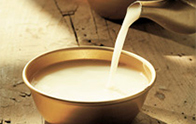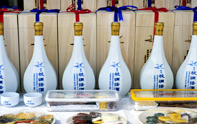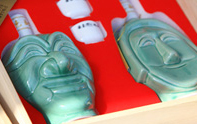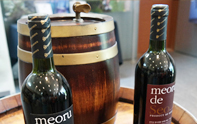 【 Photo: Variety of Korea’s traditional liquors and wines 】
【 Photo: Variety of Korea’s traditional liquors and wines 】Korea has various traditional liquors as Korean people have enjoyed each other’s company over a drink of alcohol since the ancient times. Korea’s representative traditional liquors are makgeolli and soju. They can easily be purchased at markets and convenience stores from Seoul to even the smallest of towns. Their low price also makes them quite popular. For those looking for more quality products, special local liquors such as Gyeongju Gyodong Beopju, Hansan Sogokju, and Andong Soju are highly recommended. These locally produced liquors are made using traditional methods passed down for generations, offering deep flavor and taste. The liquors are usually packaged in luxurious boxes, making them perfect gifts. They can be purchased at specialty liquor shops, department stores or specialty stores in each region.
-

Makgeolli (Takju)
Among all of Korea’s traditional alcohols, makgeolli has the longest history. It is made by mixing steamed glutinous rice or wheat with nuruk, a traditional fermentation starter, and water, then leaving the mixture to ferment. It has a milky, opaque color and a low alcohol content of 6-13%. It is relatively low in calories and high in proteins. It also contains high levels of yeast and lactobacillus.
Idong Makgeolli, produced in Pocheon, Gyeonggi-do, has a sweet and tangy taste similar to carbonated water. Recently, different flavors of makgeolli have become quite popular, including yuja (citron), ginseng and omija (five-flavor berry) makgeolli.
-

Cheongju
The method for making cheongju is similar to makgeolli; cheongju is the clear liquor residue that is left after straining makgeolli. Cheongju is known for its clear ("cheong" means clear) color and aromatic scent. Cheongju has been widely used in a variety of traditional rituals and ceremonies, as it is regarded as a sincere and well-prepared alcohol. Famous types of cheongju include Gyodong Beopju liquor, which is brewed in Gyeongju, Gyeongsangbuk-do. Another is Hansan Sogokju, a traditional liquor of Soecheon-gun in Chungcheongnam-do. Hansan Sogokju is characterized by deep and sweet taste and its origin dates back to 1,500 years ago.
-

Soju
Soju is the most popular liquor in Korea. The most common type is diluted soju, which is mass-produced by mixing water with spirits, a process different from the traditional method. While all have the same soju base, locally produced alcohols are generally made using the traditional method of distillation and regarded as high quality products.
Andong Soju is a type of traditional distilled liquor, aged for a long period of time for a deeper flavor. The distilling process has been handed down for years in Andong, Gyeongsangbuk-do. Although the original Andong Soju has a relatively high alcohol content of 40-50%, it is also available at 20-35% in the market.
Leegangju is one of the finest liquors from Jeonju, Jeollabuk-do, made by mixing in pears and ginger. Munbaeju is produced by a Korean Food Grand Master with a recipe handed down for generations.
-

Fruit Wine
Gwasilju is the general Korean term for fruit-based liquor. The method of making gwasilju can be divided into two categories; one is made from naturally fermented fruits and the other by mixing fruits and sugar with alcohol. Bokbunjaju (Korean black raspberry wine), maesilju (plum liquor), and meoruju (Korean grape wine) are the most common gwasilju found in supermarkets and department stores.
This page was last updated on October 6, 2021, and therefore information may differ from what is presented here.
